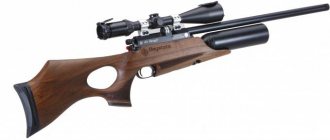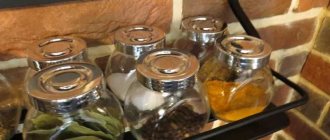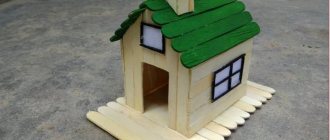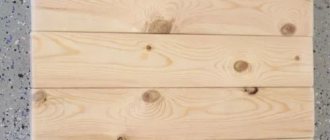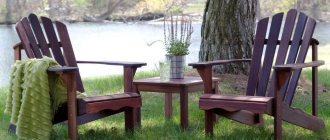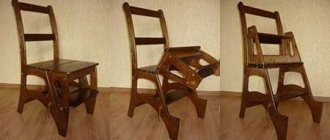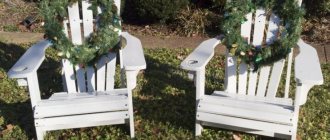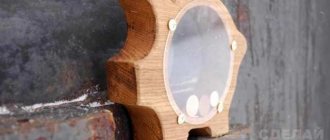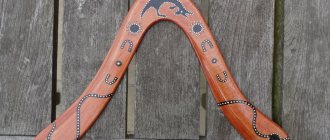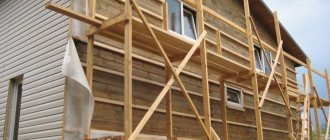Making a profile ruler with your own hands
The ruler will measure 50 cm in length, and the length of the rods will be 30 cm. This is quite a large size, but using the same principle you can make a smaller ruler.
- Two blocks of dense wood (for example, larch). Bar profile 2 cm / 5 cm, length 50 cm.
- Wooden rods are 30 cm long. Their number depends on how wide they are. Rods can be ordered from a carpentry shop; you can use ready-made ones (bamboo/wooden skewers, cosmetic sticks, etc.). You can also use welding electrodes as rods.
- Felt.
- Glue.
- 2 bolts, 2 nuts, 2 washers.
So, two 50 cm bars are, in fact, the basis of our profile line. You need to cut the felt to the size of the bars, leaving 2-3 cm on both sides.
Next, glue the felt to the bars, as shown in the photo. It is better to apply glue to the bars and place felt on top and smooth it out.
Gluing felt onto bars
The next step would be to install amplifiers along the bars, since our line will be quite long. They will strengthen the structure and prevent the bars from bending. To do this, you need to glue pieces of dense wood with a profile of 1.5/1.5 cm, as shown in the photo.
Strengthening the structure with additional bars
Next you need to place several rods between the connected bars, press them down and measure the distance between the edges of the bars. Now you need to saw off two pieces of wood to fit this gap and glue them along the edges of the bars. This will be their support after installing the bolts. This way the clamping force will be distributed evenly between the rods.
Measuring the distance between the bars with inserted rods Gluing the support bars of wood
The next step is to drill holes for the bolts. No need to drill through felt. It is better to drill holes separately on both sides and use something sharp to make a hole in the felt.
Now insert the bolts and place washers under the nuts. With the nuts loosened, insert the rods.
That's it, the profile line is ready! Thanks to the felt, the rods slide easily inside the ruler. Now you can measure the profile and secure the result by tightly tightening the nuts on both sides.
LiveInternetLiveInternet
–Categories
- ASIAN CUISINE (236)
- ANIMATION (2)
- AIR GRILL (6)
- LIBRARY (45)
- VIDEO (40)
- EVERYTHING FOR YOUR DIARY (54)
- EVERYTHING FOR PC (500)
- EVERYTHING AT YOUR HANDS (81)
- KNITTING (2509)
- DESSERT (1482)
- DESIGN (11)
- HOME BEAUTY SALON (421)
- PREPARATIONS AND CANNED PRODUCTS (110)
- LAW AND ORDER (106)
- CASUAL GAMES (2)
- SEWING & CRAFTS IDEAS (221)
- ISOTERICA (297)
- LEARNING FOREIGN LANGUAGES (171)
- INTERESTING (216)
- INTERIOR (152)
- CINEMA (118)
- CINEMA HALL (66)
- BEAUTY AND HEALTH (1573)
- COOKING (4714)
- CUISINES OF THE WORLD (379)
- LANDSCAPE (4)
- MICROWAVE (106)
- MUSIC (117)
- NEED TO KNOW (292)
- DRINKS (76)
- EDUCATION (57)
- STEAMER (15)
- REmodel (80)
- UTILITIES (839)
- USEFUL AND INTERESTING LINKS (156)
- POLITICS (357)
- JOKES (82)
- PSYCHOLOGY (79)
- TRAVEL (85)
- PATCHWORK (6)
- REPAIR (111)
- HANDCRAFTS (448)
- GARDEN AND VEGETABLE VEGETABLE (55)
- WEDDING (6)
- SCRAPBOOKING (37)
- SOFT (88)
- STYLE AND FASHION (67)
- POEMS (103)
- KITCHEN APPLIANCES (42)
- PHOTO (1)
- PHOTO GALLERY (28)
- FLORICULTURE (122)
- SEWING (866)
-Music
–Search by diary
–Subscription by e-mail
–Interests
– Regular readers
-Statistics
Another homemade template ruler
Now let's look at an interesting budget version of the profile line, which is very easy to manufacture.
To make it, we only need corrugated cardboard and bamboo skewers.
Take the corrugated cardboard from the packaging box and cut a piece of the length you need. There is no need to make the cut too narrow. Do something like in the photo above.
The advantage of such a ruler is that it can be made to any length. It can also be easily bent as you need. The rods will not tangle as each has a separate section. The sections of cardboard inside are rough and the rods (skewers) “sit” quite tightly in their places. If desired, you can modify this design. You can increase the rigidity of the cardboard by gluing a denser material onto it. The disadvantage is that the rods cannot be firmly fixed after measurement.
More interesting articles:
Forming the rear window tint film
The main stages of child development
Before you start making a toy, determine what age it will be designed for. Obviously, a toy for a one-year-old child will not be of interest to a five-year-old. It is also important what the child is interested in. It depends on what shape your toy will be and what plot it will be combined with.
I would like to remind you that everything is individual. Perhaps your child has already mastered some skill ahead of time, perhaps not.
0— 3 months
The child lies on his back most of the time. It is necessary to develop the ability to focus your gaze.
Types of toys:
mobiles, bright rattles, garlands, beads.
Closing line: jaskravyjsvit
You can make such a line yourself.
To do this, you need to glue the layout of the divisions onto the primary line. The layout will be lower. Master class with the preparation of the ruler: How to make a cutter's ruler with your own hands in 10 minutes. The cutter's ruler is designed for constructing a pattern to scale, modeling clothes and calculating fabric consumption when cutting. The cutter's ruler, in addition to the usual scale, has a special scale, where each centimeter is divided into several divisions (each division is a centimeter on a scale). The classic ruler of a cutter has a scale of 1:4, but in modern literature there are drawings made on a scale of 1:6, and patterns of small parts (cuffs, collars) in scale 1:3. Therefore, there is a need to have a universal set of scale rules. Making such a set of tailor’s rules is not at all difficult.
Print the pdf file at 1:1 scale (make sure your print settings are set to print sheets at actual size).
Checking the printed ruler
Make sure that the markings on the ruler of the printed sheet correspond to the markings of the stationery ruler.
“Laminate” the ruler with tape
“Laminate” the ruler with tape (in this case we mean adhesive tape).
Carefully cut the ruler with scissors or using a stationery knife.
for cutting new and correcting finished products
If you prefer to create or edit ready-made patterns yourself, you have probably noticed that sometimes it is difficult to draw the line of an armhole, sleeve cap, neckline or shaped details by hand without subsequent edits on paper or fabric. Two factors help to avoid adjustments – experience and a convenient pattern. And if experience is gained over time, then a convenient tailor’s ruler will be a valuable acquisition just for a beginner.
What is a universal pattern?
To correctly construct a pattern, various tools are used, including curved rulers, which help to create neat curved lines - sleeve caps, armholes, necklines, curly details and darts. You can purchase a full set - a ruler for each node. Or you can limit yourself to one purchase.
A tailor's multifunctional pattern for cutting is a plastic ruler with one right angle and several curved sides and cutouts. We can say that this is a square with a curved hypotenuse. Additionally, there are holes for convenient marking of loops, buttons and notches for combining cut details. There are also rounded holes for easy drawing out of curves.
Transparent plastic allows you to see the lines on the paper and quickly adjust the drawing. The density of the material is such that you can use a roller or stationery knife to cut out parts, limiting its movement according to the drawing with a pattern.
How to use the multi-tool?
Let's say you have already purchased a multifunctional tailor's pattern for cutting. How to properly use all the functions provided in it is one of the main questions, since the acquisition is not cheap, and you absolutely don’t want it to gather dust while you try to draw the lines of certain nodes by hand, and then edit the finished layout cut.
Pay attention to the internal holes, they have more rounded sides and are convenient for creating the seam of the seat of trousers, the cuff of the sleeves of children's products, the armhole and the output of figured parts.
When rounding the waist dart, changing patterns for flared trousers, as well as smoothly drawing out the hemline, the “hypotenuse” of the ruler will be useful. A smooth bend will help to avoid unreasonably sharp protrusions of the fabric on the product.
Thus, you can use a multifunctional tailor's pattern to cut fabric and create smooth lines on a paper drawing.
Interesting additions
It also happens that the drawing is constructed correctly, the pattern corresponds to the planned product, but during assembly the originally intended chalk lines are erased. This happens especially often during individual tailoring, when it is necessary to carry out a preliminary fitting.
It is not enough to outline the location of decorative details and buttons on the pattern; you need to correctly transfer them to the fabric. And a multifunctional tailor’s pattern can also help with this. Even if you haven’t used it for cutting fabric, this tool is literally indispensable for basting loops and correcting the placement of decorative elements. This ruler will help reduce marking time and make the notches perfectly even. This will help avoid defects in the finished product and reduce the likelihood of stretching parts made from “moving” fabrics.
No less useful will be a multifunctional tailor's pattern for cutting out front details in the case when the chest dart is moved to the armhole. In this case, an incorrect bend line can lead to excessive tension at the center of the chest. Smoothing the edge of the part in this area manually is almost impossible, and the bends provided in the tailor's ruler will turn out to be an invaluable find.
Summarizing
Note that the correct use of universal tools not only greatly reduces the time needed to create a finished product, but also helps to improve the level of your skill.
Options for toys and the skills they develop
Baby rattle bracelet
This bracelet will be useful for a very small baby (from 2 to 4 months). It will contribute to the development of the baby's hearing and vision, as well as coordination of movements.
Beads (sling beads)
Sling beads develop color perception, tactile sensations, and teach the child to pick and roll small elements. In addition to beads, you can attach several small knitted animals or fruits.
Pillow with buttons
Despite its apparent lightness, the toy is quite interesting. Buttons of different textures develop the baby's tactile perception. Take it with you on the road and ask your child (depending on his age) to find all the buttons of a certain color, count them (on the entire pillow, in one row or column), find the largest or smallest button of a certain color in a row or on the entire pillow, show which button is to the right of the small blue one, etc.
Book
Develops fine motor skills, teaches you to name animals, allows you to study colors and geometric shapes.
Stand with locks
I'm sure the boys will be absolutely delighted! After all, there is so much that can be opened, unfastened, turned and pressed. Making a development stand is quite simple; most of the elements can be found in any man’s pantry.
The rug is a fairy tale
The rug develops the child's speech and imagination. Simple guiding questions from parents will help the child quickly master these skills (Can you imagine that Kolobok turned the other way? Who will he meet? Etc.)
Do not forget that any fairy tale is also another reason to remind you of the rules of behavior (that you cannot run away from your parents, that you must obey your elders, be diligent and hardworking).
DIY profile ruler template
The profile ruler is used for quickly and accurately measuring and duplicating uneven surfaces. You can read about using a template ruler in body repair in this article. Sometimes it is better to buy a tool, but in this article we will look at three options for making a template ruler with your own hands.
Making a profile ruler with your own hands
The ruler will measure 50 cm in length, and the length of the rods will be 30 cm. This is quite a large size, but using the same principle you can make a smaller ruler.
- Two blocks of dense wood (for example, larch). Bar profile 2 cm / 5 cm, length 50 cm.
- Wooden rods are 30 cm long. Their number depends on how wide they are. Rods can be ordered from a carpentry shop; you can use ready-made ones (bamboo/wooden skewers, cosmetic sticks, etc.). You can also use welding electrodes as rods.
- Felt.
- Glue.
- 2 bolts, 2 nuts, 2 washers.
So, two 50 cm bars are, in fact, the basis of our profile line. You need to cut the felt to the size of the bars, leaving 2-3 cm on both sides.
Next, glue the felt to the bars, as shown in the photo. It is better to apply glue to the bars and place felt on top and smooth it out.
Gluing felt onto bars
The next step would be to install amplifiers along the bars, since our line will be quite long. They will strengthen the structure and prevent the bars from bending. To do this, you need to glue pieces of dense wood with a profile of 1.5/1.5 cm, as shown in the photo.
Strengthening the structure with additional bars
Next you need to place several rods between the connected bars, press them down and measure the distance between the edges of the bars. Now you need to saw off two pieces of wood to fit this gap and glue them along the edges of the bars. This will be their support after installing the bolts. This way the clamping force will be distributed evenly between the rods.
Measuring the distance between the bars with inserted rods Gluing the support bars of wood
The next step is to drill holes for the bolts. No need to drill through felt. It is better to drill holes separately on both sides and use something sharp to make a hole in the felt.
Now insert the bolts and place washers under the nuts. With the nuts loosened, insert the rods.
That's it, the profile line is ready! Thanks to the felt, the rods slide easily inside the ruler. Now you can measure the profile and secure the result by tightly tightening the nuts on both sides.
Another homemade template ruler
Now let's look at an interesting budget version of the profile line, which is very easy to manufacture.
To make it, we only need corrugated cardboard and bamboo skewers.
Take the corrugated cardboard from the packaging box and cut a piece of the length you need. There is no need to make the cut too narrow. Do something like in the photo above.
The advantage of such a ruler is that it can be made to any length. It can also be easily bent as you need. The rods will not tangle as each has a separate section. The sections of cardboard inside are rough and the rods (skewers) “sit” quite tightly in their places. If desired, you can modify this design. You can increase the rigidity of the cardboard by gluing a denser material onto it. The disadvantage is that the rods cannot be firmly fixed after measurement.
How to turn 10 school supplies into very interesting ones
With the help of this video master class, you will learn how to make very beautiful and unique things for school from the most ordinary and cheap school supplies.
1. Fluffy bookmarks in the form of a panda, rabbit, bat and Pokemon Pikachu can be made from small pompoms, a cocktail straw, cardboard or felt and glue. (In almost all crafts, the hot glue used in the video can be replaced with super glue. With the exception of the very last 10th craft.)
2. Glitter pen. To do this, you will need the glitter itself, a cheap ballpoint pen with a transparent base, PVA glue and water. Mixture ratio: 1 teaspoon glue to 3 teaspoons water.
3. Decoration for a pencil in the form of a lollipop. For this craft, you can use Play-Doh or any polymer clay. Just dry or bake it strictly according to the instructions on the package. The main thing to keep in mind is that a piece of white clay is about 4 times larger than a colored piece.
4. Smelling pencils, pens, erasers, notes. Making smelling school supplies is pretty easy. You will need a plastic container with a lid, a container in which you will place everything that you want to scent, a scented oil with your favorite scent. Add a few drops of scented oil into a container, place a container with school supplies inside, close the lid and leave overnight. Just in case, it is better to experiment with one cheap item first to determine whether you like using smelling things.
Profile bending without turning: price, parts, tools
Having decided to make a profile bending machine with his own hands, the master asks himself the following questions:
- Will a lathe be required?
- How much will a homemade product cost?
- Isn't it cheaper to buy a profile bender in a store?
To answer them, we’ll immediately show what portal participant Pin008 did.
And this is an example of work performed by a profile bender.
And this is a video showing the operation of this homemade pipe bender for a profile pipe.
If you are interested in a homemade pipe bending machine Pin008, then to make it you will need:
- bearing unit UCP 204 – 4 pcs.;
- straight channel 8 (shelf base height 8 cm, shelf width 4 cm) – 2 m;
- diamond jack from a passenger car;
- bearing 156704 – 3 pcs.;
- threaded rod M20;
- M20 nuts;
- washers for M20 stud;
- bicycle sprockets - 2 pcs.;
- bicycle chain.
- Bulgarian;
- powerful drill;
- welding inverter.
Next, we will tell you how to assemble a homemade profile bender from these parts.
How to make a simple tool for marking workpieces
In this review, we’ll look at how to make a simple tool for marking metal and wood workpieces with your own hands.
To make a homemade product you will need a metal ruler and metal 8-10 mm thick. You will also need two pieces of sheet metal (its thickness should be the same as that of the ruler).
First of all, the author takes a strip of metal and cuts two blanks of the same shape from it. We process them on a grinding machine.
Manufacturing a machine for bending profile metal pipes
The user divided the work of constructing a homemade product into a number of sequential steps:
- I estimated the dimensions of the profile bender.
- I took the screw part from a car jack to make a pressure screw.
- I tried on the details.
- I assembled the body of a bending machine from a channel.
- Made the videos. The Pin008 axis was made from an M20 threaded rod. To do this, he cut it with a grinder into pieces of the required length.
- Stages of manufacturing a pressure roller.
- Assembling the profile bending frame. The top bar is removable for easy installation of the pressure roller.
The photo below clearly shows how to make a pressure roller for a profile bender.
Next, Pin008 made the locknuts. He did it like this:
- I screwed the nut onto the stud and secured it with a second nut.
- I clamped the workpiece with a clamp, and sawed the nut with a grinder with a thin cutting disc.
Assembled structure.
The sprockets for the Pin008 chain drive were secured to the nuts by welding.
Next, Pin008 assembled the profile bender. I painted it and used it for its intended purpose.
Because Pin008 didn’t make homemade drawings, so to clarify the dimensions of the machine, he attached a tape measure to the profile bender.
I think it’s not worth taking a smaller channel. The weight of the bed will decrease and the machine will stand unstable. The distance between the roller axes should not be less than 300 mm either. Otherwise, the load on the rollers and bearings will increase and their cages will burst. I note that the movement of the clamping screw is so light that it can be turned with one finger.
When making a homemade profile bender, remember that the smaller the axial distance between the rollers, the smaller the radius of the workpiece that is bent on the machine. But the load on the rollers will increase, and hence the bearings. The bend radius is regulated by the amount of lowering of the pressure roller, and it is limited by the height of the central part of the frame and the length of the threaded part of the pressure screw.
Tips for making a profile bender, and how to reduce the cost of its construction
The operation of the profile bender showed that the homemade product was a success and is optimally suited for bending 20x20 mm pipes. For larger pipes, you will have to make changes to the design - increase the width of the working part of the rollers and strengthen the frame. Another point is that users who were interested in homemade products had doubts about the strength and durability of the shaft made from a threaded rod. But 5 years of using the tool have proven that the idea works. According to Pin008, during the entire operation of the homemade product, nothing broke. The only thing he would do is give up the two large washers on the pressure roller. They are simply not needed.
And he would have taken a larger width pressure bearing.
Important nuance! The lower rollers do not rotate relative to the stud , because “tightly” clamped on both sides with nuts. But the shafts themselves rotate in outer races - in bearings located in the frame supports.
This suggested to Pin008 how to reduce the cost of the design.
For the lower rollers, do not buy new bearings, but look for “dead” ones at car services. They still don't spin on the shafts. Ask your friends for the chain and sprockets, in case you have some “unnecessary and superfluous” junk lying around. Buy the stud and channel at metal collection points.
But val-lel, from his own experience, advises looking in car services for discarded timing chains and camshaft sprockets from a VAZ engine. All you need is two identical sprockets and one chain. Even if the sprockets have signs of wear and the chains are stretched, this does not matter for a homemade machine.
You can join the discussion of a homemade machine in the topic Arch profile bending without lathe.
We recommend reading the articles:
- Homemade sawhorses for sawing firewood and a wood splitter: drawings, design, use experience
- Do-it-yourself manual machine for bending reinforcement - the cheapest and simplest options for homemade reinforcement benders
- Helpers in metal work for the home workshop: a circular saw for metal, a circular cutting machine, how to cut metal with a jigsaw
Milling ruler
The author shares the secrets of making a table and ruler for a milling machine. With the adjustable pads of a homemade ruler, it is easy to rout straight and at right angles. Its design also includes a pipe for connecting a sawdust extraction system.
HOMEMADE MILLING MACHINE TABLE
Until recently, we could not buy a milling machine that would be convenient for performing various jobs. And although over time, manufacturers have saturated the market with excellent milling machines, there is still, to this day, a reason to discuss the construction or improvement of an old machine, and with your own hands. A homemade milling machine will cost less than a new one and, in addition, you can customize it to suit the use in your workshop.
But all the benefits of your improvement can be realized only with high-quality manufacturing of an albeit not very complex, but effective device. Therefore, you need to pay special attention to every detail.
The determining parameter for the quality of a milling machine as a tool is the accuracy of its working table. Ideally, the table should have a flat top, stable and massive. Therefore, the tabletop must be made from two glued sheets of 20-mm plywood. But there is a nuance here. If the sheets are warped, then there will be troubles when milling not only long, but also medium-length parts.
Table irregularities will raise or lower the part as it passes through the cutter area, resulting in an incorrectly milled profile.
When choosing plywood for your router table, select the flattest sheet you can find and lay it so that the bulge, if there is one, “looks” up. A somewhat convex surface of the table, ensuring full and constant contact of the cutter with the length being processed, is more acceptable than a table that has a downward deflection in the area of the cutter.
MILLING RULER
If the table for your router is successful, then you can think about improvements. For example, the work requires a special ruler that allows you to accurately position the workpiece relative to the cutter. This ruler can also be used on a factory-made machine.
Milling ruler
- This is a useful tool for a milling machine or circular saw. It’s easy to make it yourself by assembling several parts exactly cut from Karelian birch plywood. By changing the dimensions, you can adapt this ruler to any milling machine. Therefore, before starting to make a ruler, measure the distance from the front edge of the work table to the cutter on your machine.
Although the design of the ruler is quite simple, it will somewhat expand the capabilities of the machine and make working on it enjoyable. For novice carpenters, a groove cut into the rear end of the ruler base will be especially convenient, which allows you to quickly release the ruler mount, move it and install it closer or further from the cutter. The pin in the slot serves as a reference point for rotation and lateral movement of the ruler. Tightening the pin handle instantly secures the rear end of the ruler to the router table, and a quick clamp at the front end of the ruler locks it securely in position. What if you need to reduce your drinking a little? You only need to loosen the clamp (this is convenient to do if the clamp is located under your right hand), easily knock or push the ruler in the desired direction and tighten it again.
The ruler also has a dust collector box with a pipe attached to the back side of the ruler. The dust collector not only serves as a trap for sawdust during milling, but also serves as a rigidity element that holds the face of the ruler at an angle of 90° to the table. Although the sawdust storage unit is quite small, in combination with the exhaust system (you can also use a regular vacuum cleaner) it works very effectively.
Finally, the ruler has two separate adjustable pads that allow you to mill parts with high quality. The pads can be brought completely together or moved apart by 100 mm. This will allow you to install any cutter, and then adjust the pads so that they are at a distance of about 3 mm from the surface being processed. This ensures clean and precise milling passes with minimal chipping of the material and improves the selection of sawdust by the suction system. There is a triangular plane on the front pad that serves as a clamping handle and at the same time a good protective guard.
MANUFACTURING A RULER
All parts of the line are made from 6-mm Russian-made Karelian birch plywood. It is sold in sheets of 1500×1500 mm. To make a ruler, start by cutting out (according to the dimensions appropriate for your machine) the ruler itself and its base. Then, from the bottom side of the ruler and the front side of the base, cut out a semicircle with a radius of 50 mm. The centers of both semicircular cutouts should be located at a distance of 300 mm from the right end of each of these parts. At a distance of 85 mm from the left end of the base, cut out a 10×58 mm transverse groove for the pin securing the base of the ruler to the table.
On the ruler itself, at a distance of 38 mm from the bottom edge, cut four slits measuring 6x50 mm. Now you can glue and press the bottom end of the ruler from above to the plane of the base until the glue sets completely. The trick here is to make sure the ruler is connected exactly flush with the front end of the base. Reinforce the joint with a few finishing nails and check that the assembly is square along the entire length of the straight edge.
Then cut out the dust collector parts to size and make a 075 mm hole in the center of the back wall blank. Glue, nail and compress the dust collector housing assembly and allow the glue to set for at least a few hours. Then center the dust collector over the opening at the base of the ruler and attach it as described above, additionally screwing it to the ruler with two self-tapping screws.
Drill holes in the linings for the mounting bolts. Start by drilling 016mm recesses for the bolt heads. Drill these blind holes to a depth of 5 mm, and in the center of them drill 06 mm through holes for the bolt shanks. Drive a mounting bolt into each of them and, putting washers on them, screw in wing nuts. Attach the finished overlays with bolts to the ruler.
To install a ruler on the router table, position it so that the cutter is located exactly in the center of the opening in the ruler. Mark the position of the groove in the base of the ruler relative to the machine table. Using the mark, drill a hole in the table for the threaded rod. Cut the threaded rod to the required length, put two washers on it and screw on two wing nuts. Place the lower nut on the glue, and the upper one serves to tighten or loosen the ruler assembly on the machine table. Place a clamp at the other end of the ruler and you can start milling.
Making Instructions: Circular Saw Guide
Anyone who has worked with a hand-held circular saw at least once knows how difficult it is to make a clear and even cut with it. Many solve this problem with the help of simple devices, such as a strip of plywood or plastic, which is fixed to the surface with clamps. However, it is much more convenient to use a special guide rail for this purpose.
Such a device is very rarely included in the package of a hand-held circular saw, and in stores it is offered at a price often comparable to the cost of the saw itself. This seems strange, because it is not distinguished by the complexity of its design. If you have the necessary materials, it is quite possible to make a guide bar yourself, which we will discuss in this article.
Tags: toe adjustment
Comments 55
Great! I’ll also do it... full of old calipers)...
An excellent tool, but how to initially determine the axle of a car? After all, you need to dance from her, no?
There is no need to define the axis. The distance between two points of the wheels at the front is measured, then the car rolls forward half a turn of the wheel and the distance between the same points at the rear is measured. The difference in readings is used to measure toe-in.
how to synchronize with another axis? I mean, we adjusted the front wheels, and then we need to adjust the rear wheels relative to the front ones, since we do not take into account the car’s axle.
I will write about the adjustment technology later in another post, when I take photos
This is a really useful tool!
I respect people with hands!
Thank you! It’s always a good idea to think about what it’s for before buying something.
+1 Signature, come visit!
It’s cool, but Kent set it up with a roulette and drove around for a year, everything’s fine.
A tape measure can be used to measure very roughly. Ultimately, this inaccuracy will affect the wear of the rubber.
I don’t argue that this is true, but he skated for a year on two sets and was fine.
You just need to add a spring for ease of operation to select the gaps. And that's a good idea.
My previous version had a spring, and it turned out to be inconvenient. And in this design there are no gaps, it measures very accurately.
I took note, there is no trust in the servicemen, they don’t like the Volga.
Excellent adaptation. It’s clear that engineering thinking is involved, how to set the steering wheel straight?
I set the steering wheel straight initially by pulling the rubber band between the rear and front wheels. I’ll write more about this later when I take photos.
What it is?
Essentially, a guide bar is a rail that allows a hand-held circular saw to slide forward and backward while preventing the tool from deviating from the cutting line. But a properly designed guide not only ensures an even cut, it also reduces the number of chips where the saw and the material come into contact.
Homemade guides have different designs and are made from different materials. Eg:
- plywood guide;
- rail miter box from a corner;
- aluminum profile tire;
- ruler from the building code;
- external carriage on bearings.
The miter box and remote carriage are the most difficult to manufacture. A plywood guide or profile rail is much simpler in design, but this does not mean that the cut made with their help will not be of such high quality. The difference between these varieties largely lies in ease of use.
SJRacing - tuning components for your car
Hello dear readers!
Today the object of our attention is the profile line. Another name for this tool is a profile template. This tool can be very useful in auto body repairs. This is the case when, having purchased a tool, you wonder how you ever managed without it. What kind of line is this? Let's take a closer look.
Auto body repair people know that it takes more than simply reshaping a jammed body panel. It is especially not easy to restore a body panel of complex shape. There are no clear guidelines; everything has to be done by eye. At best, craftsmen cut out a template from cardboard, but this is not fast and requires a certain skill. So, a profile ruler is exactly the tool that helps you accurately determine the profile shape you need. By looking at the ruler you will already understand what and where is not reached or has been squeezed.
How does the profile ruler work and how to use it?
It consists of a body and many rods of small diameter, which move freely back and forth in it. The use of such a template ruler is not limited to the field of body repair. Rather, this device came to bodybuilders from other areas. It has found application in woodworking, restoration of furniture and interior work, model making and other areas.
In body repair, a ruler can be used using the fact of body symmetry. That is, you can copy the shape of the panel from the other, mirrored side of the car.
It is very simple to use: just apply the tool to the desired surface and press lightly. The ends of the rods move and take the shape of the place on the body panel to which you applied the profile ruler.
Next, by applying the resulting template to the damaged area, you can understand in which direction to move when straightening the panel. Here you need to understand that you need to position the ruler so that it rests on entire parts of the panel and, as it were, continues the desired profile. If you simply apply the resulting template inside the dent, you will not understand anything.
It happens that you not only need to return the desired shape, but actually make the element anew. This may happen in the case of cutting off an area of the body that is rusted through. For example, when replacing a rusty rear fender arch. A template ruler will help you recreate the desired shape.
What are the profile lines?
This device is produced by different manufacturers from different materials. There are plastic products, metal and wood, combined and even bamboo. In body repair, the WURTH profile line is well known, but this is not the only manufacturer of such a product.
Profile ruler with bamboo rods Template ruler consisting of two sections
We list the parameters that need to be taken into account when choosing a profile line:
- The material from which the instrument is made. This is not a very important parameter; the main thing is that everything is implemented well and functions reliably.
- Ruler length. Too short is undesirable, since you often have to work with extensive damage.
- Length of rods (affects measurement depth).
A set of profile rulers from WURTH with a holder. For
example, here are the parameters of a template ruler from WURTH:
- The ruler has a plastic body and metal rods.
- Length: 40 cm.
- Rod length 8 cm (measurement depth: 7 cm)
You can purchase a set of two template rulers with a special holder. Thus, by connecting two rulers you can make a block about 1 m long.
As mentioned above, what is important is not so much the material from which the profile ruler is made, but the quality of manufacturing and mating of parts. It is important that the rods do not get stuck, tangle with each other, or become loose over time. It is necessary that the rods, having formed the contour of the shape, hold it as long as necessary.
Can I do it myself?
Looking at this tool, the craftsmen understand that there is nothing complicated in the design of this device. The idea immediately arises of making such a device yourself. However, there are not many, if any, high-quality implementations of the profile line.
Homemade profile ruler
In a separate article I will show several ways to make a good template ruler with your own hands.
More interesting articles:
From plywood
This is one of the simplest universal guide options for a hand-made circular saw, and therefore it is most common in home workshops. Let us consider in detail the process of its manufacture and the principle of operation.
Necessary materials
To make such a tire you will need three pieces of plywood 10 mm thick. Their length should be the same and is usually equal to the length of the workbench on which the work will be done. One of the segments should be 25-35 cm wide (it will serve as the base), the width of the other two will be determined during the manufacture of the tire. Also prepare 16 mm wood screws.
Drawing with dimensions:
Manufacturing instructions
When creating a guide, all dimensions must be observed very accurately. Small deviations can lead to a sharp deterioration in the result. If desired, laminate can be used instead of plywood.
The plywood guide rail is made in several steps:
- Measure the distance from the inner edge of the saw blade to the rip guide groove located on the tool support platform.
- Cut one of the plywood strips so that its width is 0.2-0.5 mm less than the distance obtained in step 1. The grains of the top layer of veneer on plywood should be directed longitudinally.
- Using self-tapping screws, screw the resulting strip to a wide piece of plywood (base), precisely aligning their ends. This will be the working edge of the tire.
- Using a caliper, measure the width of the longitudinal cut guide groove.
- Screw the remaining strip of plywood to the base parallel to the first strip. There should be a gap between them, the size of which should be 0.2-0.5 mm less than the width of the groove measured in the previous paragraph.
- To avoid damaging the material being cut, a layer of soft fabric is glued to the finished guide on the bottom side.
Important: before measuring the soleplate of a circular saw, be sure to disconnect it from the power supply!
The homemade guide is ready, all that remains is to prepare the hand saw. To do this, saw off a narrow strip of thick plywood or other sufficiently durable material. The height of this strip should be 8-9 mm greater than the depth of the guide groove on the saw base. The width corresponds to the width of this groove. The length is several centimeters longer than the length of the sole.
The resulting limiter strip should be secured in the guide groove so that it protrudes beyond both edges of the sole.
How to use plywood tire?
To make a cut, you will need two clamps and two flat pieces of wood slightly thicker than the work piece. The guide rail is installed with its ends on these bars so that its working edge protrudes slightly beyond the edge of the workbench table top. In places where the tire rests on the bars, it is tightly fastened with clamps to the workbench.
The workpiece to be cut with a cutting line pre-marked with a pencil is placed under the tire, and the cutting line is aligned with its working edge. Finally, a circular piece with a limit strip attached to it is installed on the tire so that the limiter on the sole fits exactly into the prepared gap. Now you can saw, holding the workpiece with your free hand and lightly pressing the saw towards the workbench.
Choosing suitable pencils
Pencils intended for drawing are indispensable when performing any work. The artist uses this tool both for sketching and for completing drawings. A pencil is necessary when creating a plan for a future building or piece of furniture.
These 2 letters in Russian markings mean (hard-soft). In the English version, medium hard-softness corresponds to the designation HB. The fact is that the beginner is not yet used to working with a pencil and feels pressure. Therefore, when drawing, even a high-quality eraser cannot remove incorrectly drawn lines. You can erase pencil marks, but it is impossible to remove the indented groove left by strong pressure.
A set of pencils and leads for drawing. After your hand gets used to working with the tool, you can move on to softer models. When it comes to drawing, hard pencils are the best choice.
It is important that their sharpening is carried out technically correctly. You need to learn how to hold a pencil in your hand correctly
Hard drafting tools leave light gray marks behind.
For the drawing it is important that there is more darkness in the shadows. It will take longer to draw with TM
Using a soft pencil allows you to do shading in one layer. Buy automatic products of 2 types:
- for drawing extension lines - a pencil with a 0.2 mm lead;
- for main lines - with a rod diameter of 0.5 mm.
Automatic pencils require replaceable refills. They are convenient to use: there is no need for sharpening.
Drawing pencils
There is a special series of pencils “Constructor”. These are some of the best pencils for sketching and drawing projects. Each pencil has its own special markings. And this is not without reason. Different lines are drawn with pencils of varying degrees of softness and hardness. Have you probably noticed letters and numbers on pencils: 2T, T, TM, M, 2M, 3M and even 5M? What do they mean?
This indicates the softness of the pencil lead. T - hard, TM - hard-soft, M - soft. The numbers indicate the degree of hardness or softness.
Let's say you need to shade a part with thin gray lines. A pencil marked 2T is suitable for this purpose. And if you need to draw a bold frame, then take a 3M pencil. It will allow you to apply a wide line in one pass. It is impossible to make such a line with a hard pencil. Foreign pencils are marked with the letters N and V. N - hard, HB - hard-soft, B - soft or bold.
Other types
If for some reason the plywood rail does not meet your requirements, you can make the guide of a more complex design. Below are a few more examples of guides for a manual circular saw that anyone can make with their own hands.
Aluminum profile tire
This type of tire differs from a simple plywood tire in that a U-shaped aluminum profile is installed in the guide gap. Its advantage is that the rigidity of aluminum slightly increases the cutting accuracy.
For better sliding of the saw along the bar, as limiters, you can attach not thick plywood to the guide groove of the sole, but a pair of cylinders of suitable height made of fluoroplastic or other material with a low coefficient of friction.
Ruler from a building code
There are long aluminum rules that are used by finishers to level walls. To make a guide ruler with your own hands, rules are suitable, the design of which provides a groove for the free movement of the handles.
The main advantage of such a line is the absence of elements protruding above the surface of the workbench. To do this, you need to take two collapsible clamps and slightly modernize them.
The handles are removed from the rule, and their upper parts from the clamps, which are replaced with polypropylene or fluoroplastic inserts. The profile of these inserts must be T-shaped so that they can be installed with the wide part into the rule groove and be held there.
The result is a ruler that is attached to the workbench only at the bottom. This will allow you to move the saw freely in the work area without fear of getting caught on something.
However, such a tool cannot be called a full-fledged tire. This is the ruler that needs to be adjusted before each cut.
Rail miter box
This device is most often used for cross cutting (trimming) of material.
Usually it consists of two parallel metal corners, the ends of which are rigidly fixed to a plywood or metal base.
The saw platform moves freely along the corners, as if on rails.
The corners are secured with bolts or studs, which are also used to adjust the height of the “rails” relative to the base. The height should be such that the material to be cut fits freely under the corners.
To make the saw movement smoother, the corners on the inside can be glued with a material with a high slip coefficient. For even smoother movement, you can install the saw sole on a platform with metal wheels.
External carriage on bearings
A circular saw on an external carriage is more like a stationary format-cutting machine. This design is highly stable and, accordingly, provides high cutting accuracy.
The remote carriage is made of a metal I-beam, which is firmly attached with its lower plane to the workbench. The carriage itself moves along the upper plane - a platform, the lower edges of which are bent inside the I-beam and are equipped with bearings that allow it to slide freely. These same bearings, tightly pressed to the I-beam axis, eliminate lateral play of the carriage.
The saw sole is attached parallel to the carriage on the external guide. The guide can be made of two parallel angles or pipes - thus, by moving the sole of the saw, you can adjust the size of the cut of the material.
This design is good because the saw support platform is adjacent directly to the workpiece, which means the cutting depth is not reduced.
Materials
A gate made of wood is most often made in cases where the fence itself is also built of wood. In other cases, it is recommended to make the gate metal. For wooden supports, use well-dried pine or spruce timber, treated with antiseptics and fire retardants. Protective impregnations slow down or prevent the destruction of wood.
If the soil on the site is stable and not prone to frost heaving, then the supports are simply dug into the ground. On weak, subsiding, heaving soils, screw piles are used as supports or pillars are concreted deep into the ground. The holes for installing supports are made at least 0.1-0.2 cm deeper than the freezing point of the soil.
To prevent the wicket from skewing, the structure is reinforced with two horizontal jumpers. One is placed at the top of the opening, the second at the very bottom, or even buried 0.2-0.3 m into the ground.
The most popular design options are garden gates made of metal, timber or boards. To fill the canvas, use corrugated sheets, asbestos-cement slate, metal picket fence, polycarbonate, wooden picket fence, steel sheet, welded mesh or chain-link, steel rod, corrugated pipe. The canvas is made from one material or several are combined, and the canvas is decorated with forged elements. There are a lot of design options, and most often they use corrugated pipe for supports, and the filling is selected so that it harmonizes with the fence.
